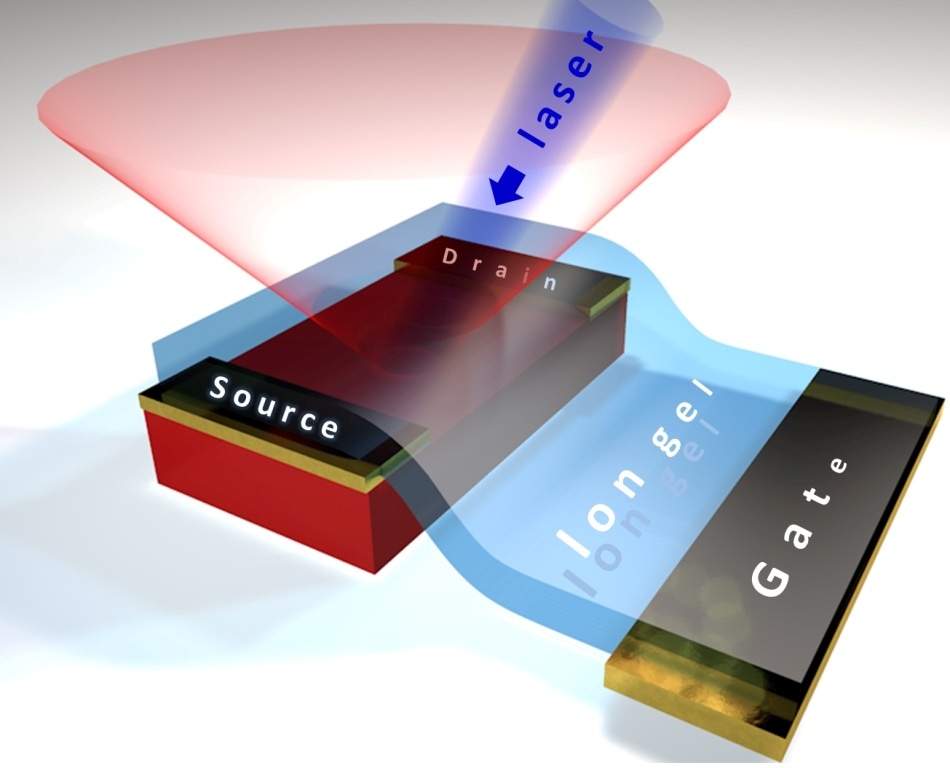Mar 7 2019
According to a study by Rutgers-led research team, reported in Materials Today, a new method to control light discharged by exotic crystal semiconductors has been discovered by the researchers, which can possibly lead to more efficient solar cells and other developments in electronics.
 A conceptual view of a transistor device that controls photoluminescence (the light red cone) emitted by a hybrid perovskite crystal (the red box) that is excited by a blue laser beam after voltage is applied to an electrode (the gate). (Image credit: Vitaly Podzorov and Yaroslav Rodionov)
A conceptual view of a transistor device that controls photoluminescence (the light red cone) emitted by a hybrid perovskite crystal (the red box) that is excited by a blue laser beam after voltage is applied to an electrode (the gate). (Image credit: Vitaly Podzorov and Yaroslav Rodionov)
Their discovery entails crystals known as hybrid perovskites, comprising of interlocking organic and inorganic materials. These crystals have exhibited a significant potential for use in solar cells. The study outcomes could result in sensors, novel electronic displays, and other devices operated by light, as well as could provide increased efficiency cost-effectively in the manufacturing of optoelectronics that use light.
The research team at Rutgers University discovered a new method to control light (called photoluminescence) given out during the excitation of perovskites by a laser. The intensity of the light emitted from a hybrid perovskite crystal can be increased up to 100-fold by just slightly changing the voltage applied to an electrode on the crystal surface.
To the best of our knowledge, this is the first time that the photoluminescence of a material has been reversibly controlled to such a wide degree with voltage. Previously, to change the intensity of photoluminescence, you had to change the temperature or apply enormous pressure to a crystal, which was cumbersome and costly. We can do it simply within a small electronic device at room temperature.
Vitaly Podzorov, Study Senior Author, Professor, Department of Physics and Astronomy, School of Arts and Sciences, Rutgers University–New Brunswick.
Semiconductors such as the perovskites possess properties that are between those of the metals that are conductors of electricity and nonconducting insulators. Their conductivity can be adjusted over a very broad range, making them essential for all present-day electronics.
All the wonderful modern electronic gadgets and technologies we enjoy today, be it a smartphone, a memory stick, powerful telecommunications and the internet, high-resolution cameras or supercomputers, have become possible largely due to the decades of painstaking research in semiconductor physics.
Vitaly Podzorov, Study Senior Author, Professor, Department of Physics and Astronomy, School of Arts and Sciences, Rutgers University–New Brunswick.
It is important to understand photoluminescence to design devices such as solar cells, light sensors, and LED lights, which can emit, control, or detect light. The researchers discovered that crystal defect reduces the emission of light and the applied voltage restores the photoluminescence intensity.
Hybrid perovskites are highly efficient and could be prepared easily and cost-effectively than conventional commercial silicon-based solar cells, and according to Podzorov, their widespread use could be achieved through this study. According to Podzorov, future research would be on investigating different types of perovskite materials that are better and more efficient—materials in which photoluminescence can be controlled over a broad range of intensities or with lesser voltage.
This study included lead author Hee Taek Yi in Rutgers’ Department of Physics and Astronomy and co-authors Assistant Research Professor Sylvie Rangan and Professor Robert A. Bartynski, department chair. Researchers at the University of Minnesota and the University of Texas at Dallas contributed to this study.